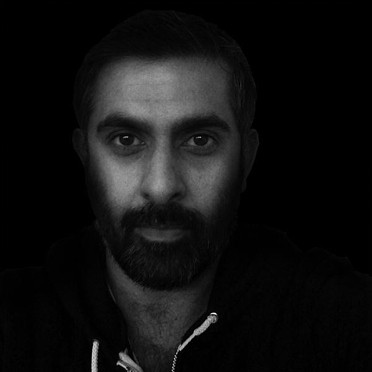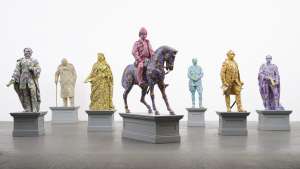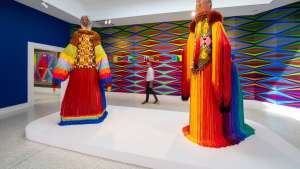First Published in

First of all, can you tell us a bit about yourself, your background and how this has influenced the way you work today?
I started my life as a designer (of sorts) as a graffiti artist. Like most of us graphic designers my teenage years were full of hip-hop and since I was useless at the dancing side, I ended up writing on walls instead of dancing on floors. As the basis of any piece of graffiti is words and letter forms, how they can be manipulated, coloured and turned into pictures‚ I spent a lot of time engulfed in that world. When I finally got nicked one time too many, I had already found uses for the skills that I had learned from graffiti and a love of type. I went and blagged my way into art college in Newcastle (north England) much on the strength of my graffiti work and the rest is history. After graduating, while supporting myself with short bits of work experience at i-D Magazine and various TV studios, helping out on set designs, I landed my first and only real job at Digit when Daljit, our creative director, had just founded the company, which is where I still am.
Tell us a bit about Digit and your involvement there.
As I mentioned I joined Digit when it started and am currently the art director. I have an accomplice called Merlin and we share the responsiblility for the look and feel of all the studio's output.
As anyone working in the new media industry would testify, it's an environment characterised by rapid development and continual change. How has your attitude or outlook to interactive media changed over the last few years?
The rapid development and constant flux is what I really love about it, when I was in college, the thing that I felt really challenged by, was interactive media. No one knew how to teach the basics and understanding of it let alone teach software so I was kind of on my own, stuck in the corner of the class with some weird motion-graphics kids and a handful of information designers talking and finding out new things. I got put onto Edward Tuffte, Karel Martens and Hans Neuburg and started teaching myself what I needed to know. Still, today things around me baffle me totally. That's what gets me excited- today my attitude is kind of again in flux. I actually miss doing a bit of print design and have made plans to address that next year and also the same with motion graphics. I kind of feel like that there are a lot of creative barriers in web design for clients a lot of the time. You can break them but not as often as you'd like...and clients have a lot more savvy so, well-known brands (naming no names) all want good solid creative, great technical work and backend cms etc etc...oh and we've got £2000 ....no comment....so the work we're starting to move into the physical, interactive area is exciting, as it brings on a whole new area of thought into what we already know and starts to involve people from other areas of design and expertise ranging from electronics to architecture, which makes your working day a hell of a lot more exciting.
Since the second half of the 90s, we've seen the internet progressively dominating the new media arena. Web design has enjoyed an increasing amount of popularity and even saw some designers enjoying near "rock star" status. What are your thoughts on this? Do you think that the popularity of the internet has hindered the exploration of interactive media in its broader sense?
People who did interesting work on the web will allways continue to do so and move into more interesting areas, while people are still copying what they did three years ago...good creative people with good creative ideas are always doing something new, in theory.
Your portfolio consists both of work done for clients as well as more experimental, self-initiated projects. What is the relationship between these?
We started the work for ourselves. Daljit had come from IBM and had no creative outlet within that environment. Coming from a creative background (in fact, he did the same course as me seven years before). So we always had a space to create new ideas to work on when we were three lads in a tiny studio...we spent about 30% of our time on our own work which started to funnel into our clients work. After publishing our first cd-rom we threw a party and gave it away (very clever marketing) and invited all of London design-glitterati whom we didn't know. Following from that, we started to get some good press, thus clients started to bang down our door. You have to bear in mind that this was in the initial 'golden age' of interactive design in London, when antirom, audiorom, sunbather amaze (Danny Brown) etc. all came out and the place was really brimming with excitement about what the future held....and we all got fairly easy jobs from clients as they were all in the infancy of the internet and willing to try things out. We still spend our time on our own work today and always will but we have moved a step on with some of our ideas into digital IP and in some cases ideas for TV.
You've dealt with quite a diverse range of clients, from banks to MTV to designers like Stella McCartney. How do you reconcile your creative input into the demands of such disparate clients? Can you identify a common thread that runs through your work?
Always try to base your design on concepts or ideas....we sometimes also spend a lot more time talking to our clients than actually doing the work as you need to get a sense of trust between you. We managed to persuade Stella to take the photos for the site herself as we needed it to be as close as a creation of hers as we could but we could only do that after we had a few good talks together and she recognised what we were trying to do together. With some of the corporate clients we work with, it's just a case of waiting 'till you get to speak to the right person with the right vision within the company...it also helps if you can deal with the person who signs the cheques...
The new media or dotcom "rise and fall" is still quite fresh in our memory and has obviously had a varied impact in different parts of the world. How has this affected you personally and how do you think the new media industry is doing now?
We were lucky enough to have only had one dotcom client and they actually paid us...before they went bust, I might add....but I guess it's again just a case of whether they all had good business plans or just good ideas. Then they would have been a lot more successful than they were. A lot of them were just completely out of their depth and didn't understand the medium and what it's good for. That's the key, because then you can use it properly. Oh, and it might have helped if they had had ANY content. Nowadays, we mainly deal with real companies and look how we can help them on a business level and use the money we have wisely. We have a lot more tools to use, that allow us to tailor work and content in a much more sophisticated way and maybe even help the users!
It has left some commentators sceptical about certain aspects of the medium. What lessons are there to learn? And are we dealing with them?
People, including us, should be sceptical. We should all be a bit more wary of the ways we use our skills to sell things and to persuade...the way we work should always be an extension of how we want to be treated as people...the dotcom scenario was maybe the best lesson that we all needed to remember that consumers are people and we don't need half this shit that we are marketing....mp3 is a great way to scare the music industry, which is greatly welcomed by me, and you have to ask if mms is the next WAP.
What about the issue of interactive content? Many feel that new media has failed to deliver engaging experiences, or at least to the extent that film has. But can one compare? Interactivity is almost the opposite of narrative. Narrative flows under its author's direction, while interactivity (as seen in games) relies on the user for the motive power. Do you think that the broadcast model of other media has made us lazy? Does this scepticism stem from an inability to take on the challenge of being the "author" of our own experiences, or do you think that we are doing something fundamentally wrong with the medium?
Media has turned the masses into viewers rather then readers....it has created vernaculars so users can understand and engage with the storytelling at hand much easier and that allows us more freedom to try new ways to convey a message/story....film is film...it's the physicality of the cinema....the smell, the seats, the event , the £20. Productionwise you can't beat it online...it's a different medium...(one of my desires is to do some motion graphics next year)...but I've spent a long time and put a lot of feeling into time playing with sites and interactive experiments that are merely sketches done by talented individuals who have imbued a sense of creative difference and have cared about what they have done. An engaging experience doesn't need to be narrative-driven after all.
Where do you see interactive media heading? Can you identify areas that you think need more exploration?
Physical interaction, reactive image/motion graphics, web vernaculars/methods used in traditional media, technology and product design, interactive body piercings/adornments, rollercoasters.
Have you recently seen something that made you jealous?
Anything Andries does....and my ex-girlfriend's ex-boyfriend has just brought out an album thats really good.
Any advice for young budding African designers?
The most inspirational work that I've seen has been an expression of something that teaches the viewer something that he/she may never experience...we all have stories and experiences within our lives that people will be interested in and you have a fantastic country as a background for this. I think if you use these elements as inspiration you can't help but win. Oh, and as I said, try to work with the person who signs the cheques.











